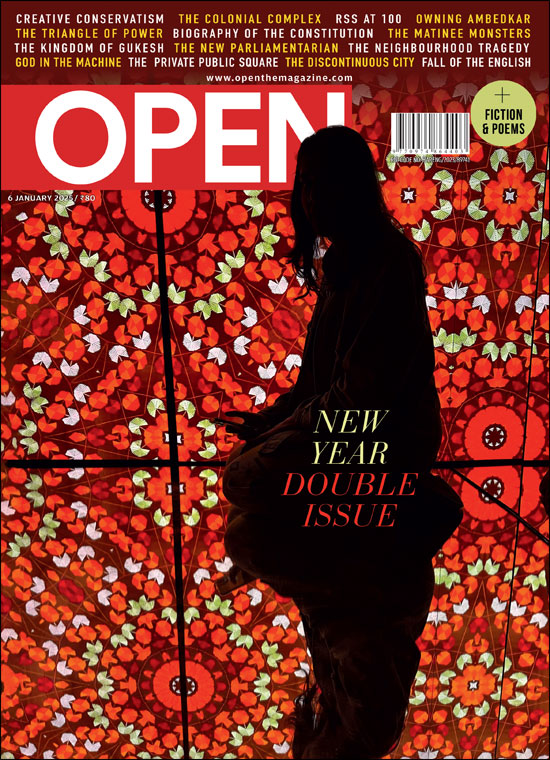The Return of the Vinyl Record
With a pop and a crackle, an old analogue technology, the vinyl record, returns
 Lhendup G Bhutia
Lhendup G Bhutia
 Lhendup G Bhutia
Lhendup G Bhutia
 |
02 Aug, 2017
|
02 Aug, 2017
/wp-content/uploads/2017/08/Vinylrecordreturns1.jpg)
EARLIER THIS YEAR, as Ashutosh Sharma and Ankur Malhotra began to prepare themselves to produce three new music albums under their indie record label Amarrass Records, a predicament presented itself. Should they release the new albums on CDs? The market for CDs had disappeared almost overnight. As Sharma says, almost all large music retail outlets in India have shut shop, with very few people appearing to use CDs to listen to music anymore. The last time Amarrass Records had released an album on a CD was over a year-and-a-half ago, when the death of the CD was becoming all too evident. Could they simply do a digital release? But a release on such a format could not do justice to the music on their hands—the wonderful Rajasthani folk and Sufi music band, Barmer Boys, the musical genius of Lakha Khan, widely considered the greatest living exponent of the Sindhi Sarangi, and the Palestinian-American group Painted Caves.
So Sharma and Malhotra did the unthinkable. In this digital utopia of quick easy downloads and free music-streaming websites, they reintroduced an ancient analogue technology. They produced the three albums on vinyl. This is the first time anyone had ever done this in India since the early 1980s, when Indian music companies, as a result of the emergence of audio cassettes and walkmans, stopped producing LPs.
Sharma and Malhotra travelled to Germany to study and procure the machinery to cut vinyl records. And earlier this year, the three albums began to appear on shiny black vinyl discs.
It may appear a sentimental decision. But Sharma and Malhotra insist it is not. The recorded-music industry worldwide is in a state of flux. The traditional formats of listening to music, CDs and audio-cassettes, hardly exist anymore. Sales from digital downloads are falling rapidly. Piracy is rampant. Most people appear to be consuming music through online music streaming services. And the revival of vinyl records seen all over the world in the last few years, according to Sharma, is also beginning to make its presence felt in India.
There has been a fair amount of suspicion about this so-called re-emergence of LP records. Some have dismissed it as a case of old sentimentalists buying countless re-issues of Pink Floyd’s Dark Side of the Moon. Others say it is a passing fad, driven by millennials who don’t even own turntables; that half the records sold will never actually be played. You can’t blame them. The graveyard of music replay technologies is filled with the headstones of so many bright lives, cut short almost tragically—the audio cassette, the walkman, the compact disc.
But year after year, even in this convenient digital utopia that we have built for ourselves, there has been a steady growth of LPs. On some occasions, spending on LPs have even eclipsed that of digital downloads. Last year was particularly noteworthy, driven no doubt by the death of several music greats and their fans wanting to get hold of a tangible piece of their music. According to the British Phonographic Industry, more than 3.2 million LPs were sold last year in the UK alone, making it also the first time in history that people have spent more money on LPs than on digital downloads. The resurrection of LPs now even has the backing of a major label. Sony Music, which had shut its in-house vinyl pressing production in Japan in 1989 after the advent of CDs, recently announced that it will restart the manufacture of its records next year.
Many reasons have been offered for this resurgence. Some say music listeners like having something large to hold in their hands. Others say vinyl is just way cooler than a download. With almost every track, bootlegged or otherwise, now easily available on torrent websites or music- streaming services, music fans need something else to boast about. Sharma believes the main reason is elementary. “A vinyl record sounds better,” he says. To him, digital music may be convenient, but if one wants to ‘listen’ to a track, then a record is superior to any other format. “The analogue sound is much better than the digital. Digitally engineered MP3s are an approximation. A digital recording does not capture the complete sound wave. Analogue is natural, more organic.”
There has been suspicion about this so-called re-emergence of LP records. Some have dismissed it as a case of sentimentalists buying re-issues of Pink Floyd. Others say it is a passing fad, driven by millennials who don’t even own turntables. You can’t blame them
Amarrass Records first came out with a vinyl title in 2010. Then, the two producers had gotten 1,000 copies of their first album, a folk music title called The Manganiyar Seduction, produced at a vinyl-pressing outlet abroad. Most of the copies, however, remained unsold. Many people were clueless about records, Sharma says. When they organised a workshop with some students of National Institute of Fashion Technology in Delhi—some of whom later helped design the cover of the new vinyl records— and showed them vinyl records, the students asked them if these were some type of a large CD. “You can’t blame them,” Sharma says, “all of them were born only after the internet.”
This time, though, seven years and several albums down the line, Sharma and Malhotra wanted to do it again. They believed the audience of LP listeners had grown a lot more since 2010. The two also wanted to have more control over their vinyl production. If they were to press new LP albums elsewhere, it was going to be incredibly time-consuming; most vinyl-pressing outlets abroad are said to be under strain to cater to the recent resurgence in demand. And they did not want to produce a huge bulk of vinyls as they had done the last time round.
They decided instead to cut their own records, an older, more labour intensive form of making records that is better suited to the production of smaller batches.
The two, however, didn’t just have to procure the machinery and learn to use it. They had to do everything from scratch. “It was everything that goes into a record, from designing the album jacket and sleeve to the actual process of cutting it. Printers here didn’t even know what a record sleeve looked like.”
Although there is a lot more awareness of and interest in LPs in India, the market, especially that for indie folk music, is still very small. Amarrass Records is now gearing to produce some new albums, apart from releasing some of the older albums, on vinyl in the next few months. They are trying to publicise their work by offering personalised merchandise—like wedding invitation cards on vinyl, where the records have audio messages as well as songs. “We can put the groom’s face on a Jimi Hendrix album. Or maybe put the bride and the groom’s faces on a Mughal-e-Azam cover. Whatever they fancy,” Sharma says.
“A vinyl record sounds better. A digital recording does not capture the complete sound wave. Analogue is natural, more organic” – Ashutosh Sharma, co-founder, Amarrass Records
In India, the market for vinyl records is tiny, but there are signs, its proponents say, of a revival. High-end turntables are being purchased by people in their twenties and thirties. Some young couples are purchasing turntables and records as they set up a new house. Crate-diggers are going to flea-markets in India, sifting through second-hand collections abroad, to pick their favourite records. And there are record clubs whose members sit together to listen to or discuss music on records.
Earlier this year, on April 22nd, The Revolver Club, a vinyl and audio shop in Mumbai, along with Sony Digital Audio Disc Corporation organised the country’s first Record Store Day across Mumbai, Delhi and Bangalore. It was a day of gathering for vinyl fans, several hundreds of them, where they listened to and purchased records. Several collectors spoke of their prized possessions.
“I am a music guy,” says Jude de Souza, one of the founders of The Revolver Club. “But I am also a businessman. And I feel there’s a lot of growth happening in the vinyl sector… When we first started it (two-and-a-half years ago), the market wasn’t that big. But we knew it would eventually grown… It is already beginning to show here. And my eventual plan is to be like the Amazon of vinyl in India.”
De Souza began his professional life in what he calls the “soul-sapping” vertical of wealth management in a multinational bank before he moved to a career in music retail. He first started a high-end audio store, Nova Audion, before he began his focus on vinyl and re-imagined the store as The Revolver Club. “Since last year, I can tell you for sure that this segment of music listeners is really growing,” he says. He sells around 40 turntables and at least around 400 vinyl records every month. Most of his customers tend to be people above the age of 40. He gets orders for vinyls and turntables from various corners, from larger cities in India to distant towns and cities like Shillong and Indore and even countries nearby like Nepal, Bhutan, and Bangladesh.
“People think millennials just stream music. Or they are just digital. But I think what we are seeing increasingly is that people still want something tangible and real. To touch and feel their music,” De Souza says. Vinyl in that regard appears to be taking on the role that the CD or the video-cassette used to have in a pre-digital era.
Many of the people who purchase turntables in India, De Souza admits, will never really take to the format. “Fifty per cent of my customers who buy turntables from me I will never hear from them, three months down the line. But with the others, I know I have them hooked for life,” De Souza says. The vinyl record, he believes, offers the listener an experience unlike any other format. There is a certain romanticism and ritualistic nature to its experience, he points out—pulling out a record from its sleeve, the flipping of the vinyl to get the correct side, and the gentle placing of the needle on the track. “The record and the turntable forces you to interact with the music, to pay attention to it. It puts music into the foreground, not the background as it happens with other formats,” he says.
“People think millennials just stream music. Or they are digital. But people still want something tangible and real. To touch and feel their music” – Jude de Souza, co-founder, The Revolver Club
One aspect of vinyl’s return, its proponents claim, is how it is reviving the forgotten art of listening to music. Lying on the floor next to one another, not speaking or moving, and in this anticipatory silence, with a pop and a crackle, listening to an old record begin to play. De Souza had a somewhat similar experience when he began listening to LPs. And this is an experience, he says, he would like replicated. He first listened to an LP at his dorm in a university in the US. Then a 17-year-old who’d recently discovered Led Zeppelin, he lugged a turntable that he found neglected in his university library all the way to his dorm. But when he put the Zeppelin LP under the needle, without putting in place the required amplifier, all he heard was a strange low hum. “Have you ever listened to an LP like that? It can make you go crazy trying to figure out where the music is coming from. All you hear is this vague sound,” he says. But De Souza got the required audio system and his love affair with the rich full-bodied music of vinyl records went high-fidelity. He speaks of the large collection he sold once he returned to India, only to painstakingly build it again over time. He talks of the songs he has lost to old memories, tracks that he discovered and listened to with old friends and partners, and which he can’t now listen to without bringing back a painful memory of separation. “You should never never lose songs to women,” he says.
SURESH CHANDVANKAR, A retired scientist at the Tata Institute of Fundamental Research, has spent a lifetime collecting records. He estimates he has around 20,000 records now. Amongst them are some incredibly rare and old shellac records, like those at the dawn of the 20th century, pre-dating Hindi film music. Some of these include the collection of Odeon records. Odeon, a German company, used to press shellac discs for Indian record collectors in the early 1900s. They recorded not just folk and classical music, but also drama songs, speeches, skits and plays. But when World War II broke out, because of an embargo imposed on German goods, the company had to wind up its business in India, leaving behind hundreds of titles which have since then travelled through collectors and flea-markets or simply gotten lost. Chandvankar remembers being first drawn towards LPs as a child, when he encountered a gramophone that was owned by his uncle. “I was expressly told not to touch [the gramophone], or any of his records. And I obviously had to.”
What followed was a mad passion to collect records. His father, a teacher, began buying records from people who sold it just to satiate his son’s needs. Today, almost all of his over 20,000 albums are stored in a house in a distant Mumbai suburb that he purchased just for this purpose. “This house of my records is one-and-a-half times the size of the house I live in,” he says.
Back in 1990, when, to the worry of Indian collectors like Chandvankar, it began to get evident that records would not make it to the next century, they came together to form the Society of Indian Record Collectors. Chandvankar is currently the honorary secretary of this group. These record collectors would meet to listen and discuss the music they owned—they published an annual periodical on records, The Record News, until recently— and, above all, to save and transmit the rich cultural legacy embodied by their treasure. “Our idea was to collect the collectors, to draw them out of the isolated empires of their collections to form such a group,” Chandvankar says. Record collectors tend to be an eccentric bunch of people who are possessive about their collections; they can be greedy and have rivalries with other collectors, Chandvankar says. But all of them decided to set these differences aside for the cause.
At the core of such preservation efforts lies an anxiety about what will happen to these collections once they pass away, since many of these albums are only of niche interest. Chandvankar has already begun to digitise his collection, making MP3 copies of the tracks on his records and putting them up online. He has already done two projects for the British Library, where he has made digital copies of these songs at the institution’s expense and uploaded them on its website. The aim, he says, is to save the songs and information on those records, even if the physical discs themselves don’t survive. He has so far gotten through 60 per cent of his collection already, he says. Every few days, he scours Mumbai’s second-hand market, Chor Bazaar, for old titles. And when he is not doing this, he is going through his own collection and digitising them.
Over time, activities of the Society of Indian Record Collectors have become less frequent. Some members still meet and sometimes talk over the phone, but their gatherings have become fewer. The annual periodical they published was discontinued a few years ago after they realised that there were several good and informative pieces on records appearing online now. The group has also expanded to include many of the younger LP listeners and collectors now.
But why do they meet less often now to listen to music? It appears an age-old affliction that has plagued so many groups of music listeners has also arrived here in this society of record collectors.
“It was a generational thing,” Chandvankar says. “Younger collectors had a different musical taste.”

/wp-content/uploads/2024/12/Cover_Double-Issue-Spl.jpg)













More Columns
Sensex Or Gold: Which Will Hit The 1-Lakh Mark In 2025? Short Post
Moscow's Misdirection on Azeri Plane Crash Sudeep Paul
Consumption gap between rural and urban India fell in 2023-24: Survey Open